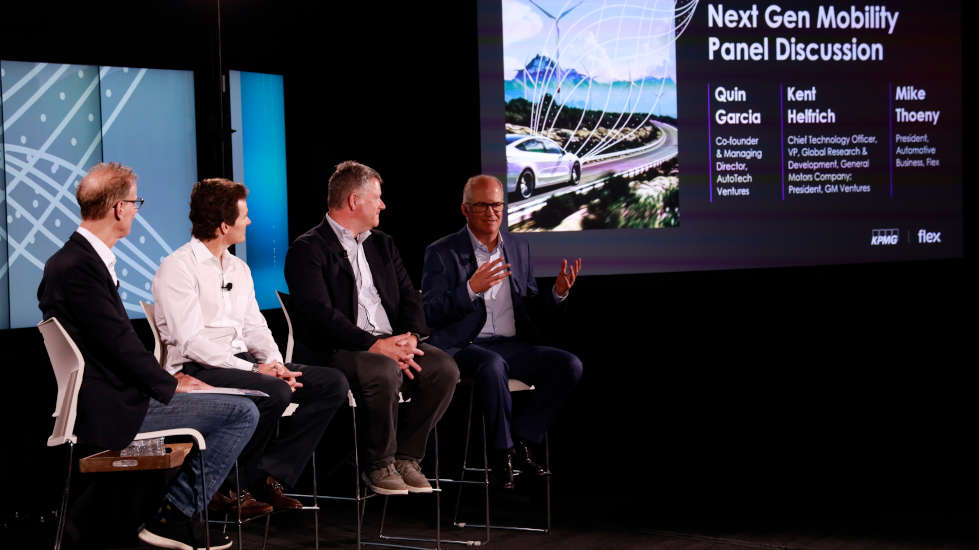
Recently, we hosted the Automotive Innovation Summit in partnership with KPMG at the Flex Milpitas Experience Center. This event, led by Gary Silberg, Partner and Global Automotive Sector Leader, KPMG LLP, and Nicole Stevenson, Vice President of Business Strategy and Marketing at Flex, brought together experts from leading brands—including General Motors and NVIDIA—to rising start-ups in the automotive space.
Our objective was to bring together automotive industry visionaries and changemakers to discuss trends driving automotive innovation and to provide a forum for attendees to learn, network, and share ideas on the future of mobility.

In my over 30 years in the automotive industry, I have never been more excited about the advancements coming down the line. As the world around us becomes smarter and more connected, the mobility industry is experiencing a massive transformational shift, one that is powered by rapid technological advancements and enabled by increased scalable compute and new business models in how OEMs and suppliers will work together.
As my peers and I discussed next-generation mobility and its potential to deliver lifesaving and life-enhancing benefits to customers, businesses and society at large, one theme resonated throughout: No one can go it alone. Next-generation mobility is a complex challenge, an enormous opportunity, and will require an emerging ecosystem to work in concert to deliver on its many promises. We will get there faster and better together.
Video Unavailable
The content you’re seeking is momentarily unavailable. We appreciate your patience and look forward to sharing it with you soon.
KPMG and Flex Automotive Innovation Summit – Next Generation Mobility Panel Replay
A once-in-a-lifetime transformation
During the Summit, experts shared compelling insights and perspectives from their real-world experiences. Topics ranged from electric vehicles (EVs), software-defined vehicle architectures and the advanced technologies to enable them, to autonomous trucks and shuttles and reimagining car subscriptions. Among the many points of view and business models discussed, several commonalities and trends emerged.
As the automotive landscape transitions to the next generation of mobility, these are the top megatrends fueling the transformation:
- EVs and power electronics
Every major automaker in the world is delivering an electrification strategy, accelerating the transition from internal combustion engines to EVs. As environmental sustainability becomes a greater priority to consumers and governments alike, automakers must be ready to meet the unprecedented growth in demand for electric vehicles, and the electronic components that enable the electrified powertrain. - Safety and convenience
Drivers today demand five-star safety and a seamless user experience, while government regulations continually advance safety requirements, driving higher sensing and compute content. We all want a future with zero accidents. - Seamless connectivity
To fully enable next-generation mobility, vehicles with software running on powerful, scalable compute platforms must have seamless, reliable and secure connectivity, from the car, to the edge, to the cloud. Consumers are already coming to expect their vehicles to update software automatically, introduce access to new features and to keep them connected to existing networks and devices. - Autonomy and ADAS
The path from advanced driver assistance systems progressing to autonomous vehicles at scale is in reach, with the business cases for mobility and delivery as-a-service (MaaS and DaaS) growing.
The rise of the software-defined vehicle
As the new and exciting era of mobility and technological acceleration takes hold, OEMs are fast becoming content and technology companies, developing their own intellectual property to differentiate their products and support growth strategies.
As automotive OEMs focus on software-defined vehicles, they are creating new vehicle architectures, consolidating vehicle features delivered by over a hundred discrete electric control units (ECUs) to an architecture composed of up-integrated zone, domain, and central compute controllers. Features are now defined by software, which can be updated transparently over the air, offering consumers access to upgrades and new content in real-time.
Industry leaders understand these new architectures must scale quickly to meet market needs. As a result, automotive semiconductor content is projected to double in size from $54 billion in 2022 to $107 billion in 2028.1
Pay attention to automotive — the growth in next-generation mobility is here and will only accelerate as we drive toward the future.
Building ecosystems to support next-generation mobility
To develop complete systems, and unique experiences, OEMs must not only continue to rely on their full-service Tier 1 suppliers, but they must also expand their collaborations to include semiconductor companies and other ecosystem partners. This focus on partnership will enable OEMs to move and innovate faster, developing and launching new features and enhancements with greater reliability and resiliency.
The business model of the future is a dynamic ecosystem of partners, whose roles may change depending on the product or customer and the cross-industry expertise needed to solve our most complex challenges. Next-generation mobility takes a next-generation ecosystem.
One example of how partnership can accelerate innovation is what we did at Flex with three system-on-a-chip (SoC) suppliers. Together, we delivered an ADAS domain controller to market in under 12 months. By working in advance with our SoC partners on reference platforms, our OEM partner was able to develop their software in parallel, speeding test and validation cycles. This type of collaboration is happening throughout the industry and resulting in positive outcomes for all.
EVs and software-defined vehicle architectures are complex and require the best minds in the industry. Being open to collaboration and new business models — whether that means leveraging a partner with targeted design capabilities or tapping into a regionalized supply chain to mitigate risk — will distinguish tomorrow’s leaders in the automotive industry.
The era of next-generation mobility is upon us. Now is the time to work together to harness its full potential.
1Source: Strategy Analytics, “Automotive Semiconductor Demand Forecast 2020 to 2029 – October 2022




